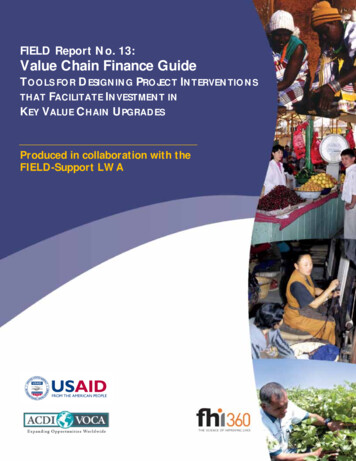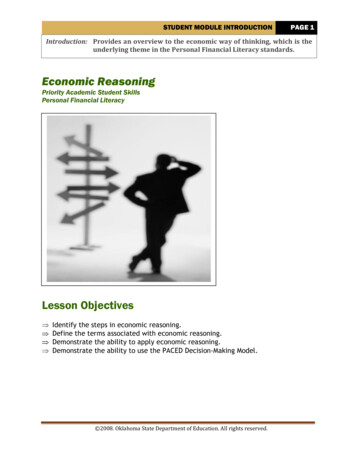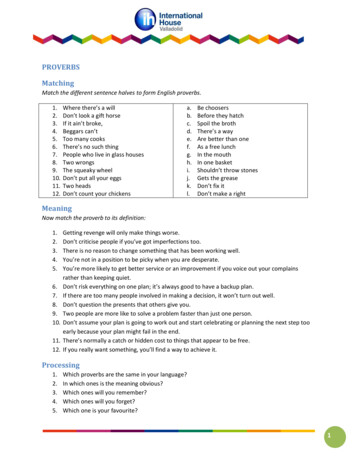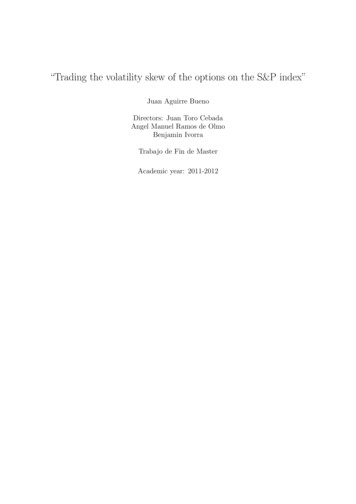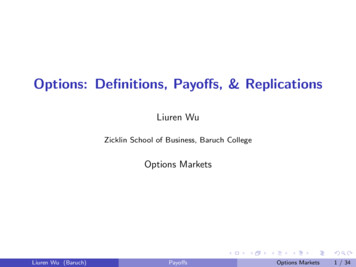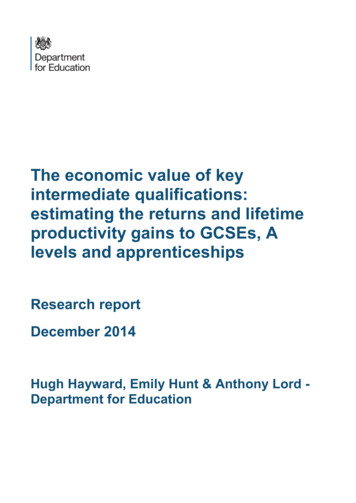
Transcription
The economic value of keyintermediate qualifications:estimating the returns and lifetimeproductivity gains to GCSEs, Alevels and apprenticeshipsResearch reportDecember 2014Hugh Hayward, Emily Hunt & Anthony Lord Department for Education
AcknowledgementsThis analysis has been undertaken by economists at the Department for Education (DfE),with substantial input from Sarah Cattan and Claire Crawford at the Institute for FiscalStudies (IFS). Claire and Sarah have advised on the analysis undertaken as part of thisproject and quality assured the implementation of the methodology. Responsibility for themethodology and results remains with DfE.We would also like to acknowledge Chris Woolliscroft for his extensive early input inpreparing the data and analysis, Daniel Mulkis for quality assuring the results, and TomMcBride, Olly Clifton-Moore and Simon Palmer for their comments and advice throughout.2
ContentsAcknowledgements2List of figures5List of tables6Executive summary8Literature review11Main findings from the literature11Data14Dependent variables14Qualification variables15Control variables16Methodology18Average and marginal returns19Regression methodology20Calculating lifetime productivity gains22Key assumptions23Other assumptions24Issues26Results28Main findings28GCSEs31A levels38Apprenticeships39Sensitivity analysis42Upper and lower estimates of lifetime productivity returns453
Conclusion48References50Annex51Data and methodology of key recent UK studies51Figures57Further sensitivity analysis594
List of figuresFigure 1: Estimated lifetime productivity returns to achieving GCSEs at A*-C as highestqualification30Figure 2: Estimated lifetime productivity returns to achieving GCSEs at A*-C, A levels andapprenticeships as highest qualification30Figure 3: Marginal returns by age to five or more good GCSEs including English and maths male34Figure 4: Chart showing the marginal returns to 2 or more A levels vs 5-7 good GCSEs ateach age and the modelled quadratic relationship43Figure 5: Marginal returns by age to 1-2 good GCSEs - men57Figure 6: Marginal returns to 2 or more A levels – men57Figure 7: Marginal returns to 2 or more A levels - women58Figure 8: Returns to level 2 apprenticeships - women585
List of tablesTable 1: Descriptive statistics – sample size . 16Table 2: List of control variables and basis. 17Table 3: Returns to five or more good GCSEs including English and maths relative to thosewith anything less . 33Table 4: Returns to achieving 1-2 good GCSEs relative to those with no qualifications . 35Table 5: Returns to achieving 3-4 good GCSEs relative to those with 1-2 good GCSEs . 35Table 6: Returns to achieving 5-7 good GCSEs including English and maths relative to thosewith 3-4 good GCSEs . 36Table 7: Returns to eight or more good GCSEs relative to those with 5-7 good GCSEs. 37Table 8: Returns to five or more good GCSEs including English and maths relative to thosewith 1-4 good GCSEs . 38Table 9: Returns to two or more A levels relative to those with 5-7 good GCSEs . 39Table 10: Returns to level 2 apprenticeships relative to those with some lower or equivalentqualifications . 40Table 11: Returns to level 3 apprenticeships relative to those with level 2 academic orvocational qualifications. 41Table 12: Assumptions for central, low and high estimates . 45Table 13: Central, low and high estimates of lifetime productivity returns – men GCSEs . 46Table 14: Central, low and high estimates of lifetime productivity returns – men otherqualifications . 46Table 15: Central, low and high estimates of lifetime productivity returns – women GCSEs 47Table 16: Central, low and high estimates of lifetime productivity returns – women otherqualifications . 47Table 17: Wage & employment returns estimates for five or more good GCSEs . 54Table 18: Wage & employment Returns estimates for A levels . 54Table 19: Wage & employment returns estimates for level 2 and level 3 apprenticeships . 55Table 20: Lifetime returns for apprenticeships. 566
Table 21 Effect of changing wage period and employment type on male lifetime productivityestimates . 59Table 22 Effect of changing wage period and employment type on female lifetimeproductivity estimates . 607
Executive summaryImproving individuals’ outcomes is a key goal of education. It is therefore important from apolicy perspective to understand the impact of qualifications in the labour market. Do morequalified individuals earn more, and are they more likely to be employed? If the answer isyes, is it possible to estimate the monetary benefits to society of a more educatedworkforce? Having robust and up-to-date evidence on the economic benefits of achievingqualifications is critical to educational investment decisions – and a key driver of thisresearch project.Numerous UK studies estimate the wage returns and the increased probability of beingemployed (employment returns) to individuals who hold particular qualifications. These arederived using data from either the Labour Force Survey (LFS) or from cohort studies whichfollow individuals throughout their lives. However, such estimates typically pre-date therecession, and in some cases, are insufficiently granular for policy appraisal purposes 1.Recent studies have also estimated the lifetime benefit to achieving qualifications throughhigher economic output (or productivity). However, these have focused on vocationalqualifications, rather than GCSEs or A levels.This paper makes a contribution to the literature by providing more up-to-date, robust andgranular estimates of the economic value of key intermediate qualifications. Our specificfocus is on GCSEs, A levels and apprenticeships at levels 2 and 3. We estimate theeconomic value of qualifications in two ways: First, we estimate the wage and employment returns to specific qualifications bycomparing the wage and employment outcomes of individuals who hold thosequalifications to similar individuals qualified to the level below. This is the most policyrelevant comparison group. We distinguish between the marginal return – for individualswho hold the qualification as their highest – and the average return – which includes allindividuals who hold the qualification. Secondly, we use these returns to estimate the economic benefit to society generated byindividuals achieving these qualifications. This is in the form of the higher lifetimeproductivity of individuals with the qualification of interest. We also take an in-depth lookat how to estimate lifetime productivity returns 2.There are three key messages that emerge from our analysis:1Existing estimates typically compare people holding five or more GCSEs graded A*-C with people holding low or noqualifications. This will hide a wide variation in outcomes: some of this group will have just scraped five C grades and otherswill have achieved ten A*s (with similar diversity in the comparison group). Most interventions result in more marginalimprovements in GCSE attainment for which no returns estimates exist. Existing estimates also fail to distinguish whetherindividuals have achieved English or maths GCSE passes, which is of policy interest.2This explicitly builds on the recommendations made by the Centre for the Analysis of Youth Transitions in 2013 forimproving the DfE appraisal methodology. These were set out in CAYT Report Number 4 (2013) ‘Assessing the economicbenefits of education: reconciling microeconomic and macroeconomic approaches’.8
Intermediate qualifications are highly valued in the labour market: achieving GCSEs, Alevels and apprenticeships is associated with significantly higher lifetime productivity. Even achieving at very low levels – just 1 or 2 GCSE passes compared to none – isassociated with large productivity gains. Modest incremental improvements in GCSE attainment also have sizeable lifetimeproductivity returns, right across the GCSE spectrum.These are based on the following key estimates 3: Individuals achieving five or more good GCSEs (including English and maths) as theirhighest qualification are estimated to have lifetime productivity gains worth around 100,000 on average, compared to those with below level 2 or no qualifications. This isequivalent to around 3 additional years of work (based on the average output of anindividual with five or more GCSEs as their highest qualification). Restricting thecomparison group to just those with no qualifications boosts the returns to five or moregood GCSEs (including English and maths) to 283,000 for men and 232,000 forwomen. Individuals who just cross the five good GCSE threshold have considerable lifetimeproductivity returns compared to those who don’t. Men holding 5-7 good GCSEs(including English and maths) as their highest qualification have lifetime productivitygains worth around 73,000 compared to those with only 3-4 good GCSEs; for women,the figure is 55,000. Men with 2 or more A levels as their highest qualification have lifetime productivityreturns of around 90,000 compared to those with 5-7 good GCSEs; for women thefigure is around 76,000. Men with level 2 apprenticeships as their highest qualification have a lifetime productivitygain of around 139,000 compared to those qualified to level 1 or level 2; the premiumfor women is around 67,000. This figure is even higher for those who acquire level 3apprenticeships as their highest qualification, with lifetime returns for men of around 175,000, compared to those who have level 2 qualifications, and around 78,000 forwomen.These returns estimates are sizeable even when we use our most conservativeassumptions. Our findings have a number of policy implications. First, the 1% of pupils wholeave school at age 16 without any qualifications do so at a large economic cost tothemselves and to society in terms of lost output. Secondly, there is a strong economicimperative that all children fulfil their educational potential, as even modest GCSEimprovements – at all levels – deliver large returns. Thirdly, the very high returns observed3All of the lifetime productivity estimates are based on first quarter 2013 prices and discounted using HMT‘Green Book’ guidance.9
for men who acquire apprenticeships, demonstrates that high-quality vocationalqualifications offer significant economic returns, and are a route which young people shouldbe encouraged to consider alongside traditional academic alternatives.10
Literature reviewThere is a rich microeconomic literature on the economic value of qualifications. Thesestudies focus on estimating the wage and employment returns to various qualifications. Todo this they use survey data on individual’s wages, qualifications and various demographiccharacteristics to run regression models which estimate the returns to individuals holdingcertain qualifications, controlling for other characteristics. Studies estimate the return toeveryone who holds the qualification of interest (known as the ‘average return’) and to thesubset of individuals who hold it as their highest qualification (the ‘marginal return’).In this section we summarise the main findings from the recent UK literature on returns toqualifications, based on three key studies: Greenwood et al (2007), McIntosh (2007), andBIS (2011). All of these studies are based on the Labour Force Survey (LFS). The LFS is alarge, nationally representative cross-sectional dataset that is widely used in estimatingreturns to education due to its rich data on qualifications and labour market outcomes. As theOffice for National Statistics undertakes the survey on a quarterly basis, the data has thebenefit of being very timely. However the key drawback of estimating returns using the LFSis that it lacks information on various background characteristics (e.g. early test scores)which would improve the accuracy of the returns estimates.Main findings from the literatureStrong wage and employment returns: Individuals who gain five or more good GCSEs as their highest qualification havemarginal wage returns of between 15% (BIS, 2011) and 25% (Greenwood et al, 2007)compared to those who hold no qualifications. This range across studies is similar whencomparing everyone who holds five or more good GCSEs to those who don’t, controllingfor other qualifications held (‘average returns’). Greenwood et al. (2007) find that individuals who acquire two or more A levels as theirhighest qualification have very high marginal wage returns; 44% compared to thoseholding no qualifications. The average returns figure is much lower when comparingeveryone who holds A levels to those who don’t, at between 9% (BIS, 2011) and 14%(Greenwood et al, 2007). BIS (2011) consider how the average wage return to holding five or more good GCSEsvaries by age. They find that, for men, the wage return rises with age, whereas forwomen the return is quadratic (“n” shaped), with the peak return in middle age. Whenconsidering the average wage return to holding one or more A levels compared to thosewho don’t hold these qualifications, they find the return by age is fairly even for men (witha high return in the final years of working life). For women, similar to the findings forGCSEs, there is a quadratic rise and fall, with a peak return in middle age. Individuals who acquire level 3, and to a lesser extent level 2, apprenticeships tend tohave very high wage returns. Studies tend to focus on marginal, rather than average,11
returns to apprenticeships 4. Level 3 apprenticeship holders have a wage return ofbetween 13% (BIS, 2011) and 18% (McIntosh, 2007) compared to individuals who hold alevel 2 qualification as their highest. The wage return for level 2 apprenticeship holderscompared to individuals who hold level 1 or other level 2 qualifications, is between 8%(BIS, 2011) and 16% (McIntosh, 2007). 5 Studies tend to use this comparison group as itclosely matches the prior qualifications of those acquiring level 2 apprenticeships. Unlike for GCSEs and A levels, apprenticeship wage returns vary considerably acrossgender, with wage returns being higher for men at both levels 2 and 3. This might reflectthe lower-paying nature of the sectors or occupations that women who holdapprenticeships go on to enter, rather than lower returns to apprenticeships inthemselves. Greenwood et al. (2007) find that employment return for individuals who gain five ormore good GCSEs as their highest qualification (including the economically inactive) isvery high at 16 percentage points6, compared to individuals who hold no qualifications.The average employment return is of a similar magnitude for all individuals who hold fiveor more good GCSEs compared to those who don’t hold these qualifications. They findthat employment returns are generally higher when using a sample that includes inactiveworkers, rather than only using the economically active sample (the latter group givingGCSE employment returns of 3 percentage points for both marginal and averagespecifications). 7 This is generally true for all other qualifications examined. A levels improve employment prospects when held as someone’s highest qualification.Greenwood et al. (2007) find that for economically active individuals who hold A levelsas their highest qualification, marginal employment returns are around 3 percentagepoints compared to someone with no qualifications. For the full sample (including theinactive), marginal returns are around 10 percentage points. Estimates of the averageemployment returns to holding A levels are varied, with BIS (2011) estimating returns ofaround 3 percentage points compared to those who don’t hold A levels, and Greenwoodet al (2007) essentially reporting zero returns, regardless of whether the sample includesinactive individuals.4The average returns methodology is problematic for apprenticeships because of defining the comparisongroup as everyone who does not hold an apprenticeship. This will encompass a very broad group of peoplequalified to different levels. It contrasts with academic qualifications where individuals usually progress in alinear way from one qualification level to the next (which means that people who don’t hold the academicqualification of interest are usually qualified to the level below).5We exclude those who hold traditional trade apprenticeships which existed prior to the introduction of themodern form of apprenticeships in 1994. This is because they are no longer of policy relevance.6A percentage point return is the arithmetic difference between two percentage values – e.g. a 3 percentagepoint increase on 50% is 53%. This is not the same as a percentage change (%), since a 3% uplift on 50%would equal 51.5%, not 53%.7The distinction between economically active and inactive workers is taken from the International LabourOrganisation (ILO). Economically active individuals are defined as those in the labour market who areemployed or who are without a job but have actively sought work in the last 4 weeks and are available to startwork in the next 2 weeks. Inactive workers are those who are not in the labour force, i.e. those who are unableto carry out work or who are not actively seeking work.12
The employment returns to apprenticeships tend to be sizeable. This is particularly thecase at level 3, where marginal and average returns for the full sample are between 11percentage points (Greenwood et al, 2007) and 16 percentage points (McIntosh, 2007)compared to those at level 2. However, given that apprenticeships are qualifications thatare undertaken in the workplace, the large returns may not be causal impacts. Employment returns are generally higher for women than men for GCSEs and A levels,but fairly similar for level 2 and level 3 apprenticeships, when considering both activeand inactive workers (i.e. the full sample). This likely reflects the fact that men generallywork regardless of their qualification level, whereas women are more likely to seek andconsequently gain employment if they become more educated.High lifetime productivity returns: Apprenticeship holders make a substantial economic contribution over their workinglifetimes in terms of higher output. Lifetime productivity returns are higher for level 3apprenticeship holders than for level 2 apprenticeship holders. McIntosh (2007) estimates the lifetime productivity gain to society from individualscompleting apprenticeships as their highest qualification, net of the costs of acquiringthese. The net lifetime productivity returns are 105,000 for level 3 apprenticeships(compared to those at level 2) and 77,000 for level 2 apprenticeships (compared tothose at level 1 or level 2). BIS (2011) find lower lifetime returns to apprenticeships atboth levels but these are based on the private gains to individuals, rather than to societyas a whole.The Annex gives a more detailed overview of the estimates at each qualification level. Theseestimates are based on the studies referenced above, and are shown in tabulated format.There are inherent difficulties making direct comparisons across studies given the varyingdata periods, methodologies, and, in some cases, comparator groups.13
DataWe use pooled quarterly Labour Force Survey (LFS) 8 data from Quarter 1 2006 to Quarter 12013 to give a good spread of data before, during and after the 2008 recession. The LFS is alarge, nationally representative cross-sectional dataset that is widely used in estimatingreturns to education due to its rich data on qualifications and labour market outcomes. As theOffice for National Statistics undertakes the survey on a quarterly basis, the data has thebenefit of being very timely. However the key drawback of estimating returns using the LFSis that it lacks information on various background characteristics (e.g. early test scores)which would improve the accuracy of the returns estimates.We only include wave 1 individuals to avoid double-counting. 9 The sample only includesthose who live in England and covers individuals from age 18 up to the current retirementage of 64 10. The sample is split by gender. For wage estimations, the sample is restricted toonly covering those who work (i.e. full and part-time) and who report non-negative hourlyearnings below 100 per hour. The data is unweighted.Dependent variablesWagesThe analysis uses gross weekly wages in the respondent’s main job, and, as a sensitivitytest, hourly wages to estimate the qualification returns. To ensure comparability, we convertwages to first quarter 2013 prices using the Consumer Prices Index11.EmploymentThe main definition of employment is generated based on whether the individual was inemployment, searching for a job (ILO unemployed) or inactive. The dependent variable takesa value of 1 if someone is in employment and 0 otherwise.8This is a quarterly sample survey of individuals in over 60,000 households, made up of five ‘waves’ each ofaround 12,000 households. It collects information about the personal circumstances, including age, maritalstatus, ethnic group, qualification and study or training, as well as the work circumstances of every adult livingin these households. For more information, refer to Jones & Smith (2001).9Individuals are interviewed each quarter for 5 quarters. Individuals are asked about wages twice, in wave 1and again in wave 5. For Q1 2006 only, we can include both wave 1 and wave 5 individuals as there is no riskof double-counting.10Lifetime productivity estimates are based on age 18-67 as, due to increases in the participation age – theminimum age individuals can leave education – and the state-pension age, this is the expected working life forschool leavers from 2015 onwards.11Based on CPI figures from the ONS available here: selector.html?cdid D7BT&dataset mm23&table-id 1.114
Qualification variablesWhen creating variables the highest qualification determinant is based on a number ofquestions covering the qualifications the person holds. Qualifications are grouped by levelsbased on the Key Skills Qualification levels.GCSE bundlesGCSE bundles are created based on a range of variables. The number of GCSEs is basedon a question on whether or not individuals have GCSEs above grade C, and subsequentquestions on the number of these. If a person has five or more GCSE passes then we usetheir response in a further question to see if these qualifications include English and/ormaths.2 A levelsWe code individuals as having 2 or more A levels based on responses to questions if theyhave more than one A level.Level 2 and level 3 apprenticeshipsApprenticeship levels are created based on answers to questions on whether the individualhas completed a Modern apprenticeship 12 since the year 2000 and what level theapprenticeship was.Table 1 below shows the sample sizes on which our regressions are based. The sample isfairly even split between men and women for GCSEs; however the cohort studyingapprenticeships is predominantly male. The more GCSEs an individual achieves the morelikely they are to progress to higher qualifications: approximately half of the individuals in oursample who gained 1-2 good GCSEs progress further in education, whereas almost 90% ofthose achieving eight or more good GCSEs continue their education after qualification age.12Modern apprenticeships are a fairly recent qualification that began in 1994; the analysis in this report doesnot look at any other type of apprenticeships. For the observations from 2012 onwards , the variable onlyincludes those who started their apprenticeships in the year 2000 or after.15
Table 1: Descriptive statistics – sample sizeMenQualificationWomenAs highestTotalAs highestTotal1-2 good GCSEs2,4385,1432,8736,3393-4 good GCSEs2,7936,8933,5718,4245-7 good GCSEs3,62512,8434,76215,1145-7 good GCSEs includingboth English and maths1,7046,0071,8536,3368 good GCSEs1,91517,5682,66825,7825 good GCSEs includingboth English and maths2,82216,9413,24817,1592 A levels 132,93412,2243,19515,008Level 2 apprenticeship2,029N/A437N/ALevel 3 apprenticeship 14396N/A87N/AControl variablesControl variables are variables that are used to improve the accuracy of the estimates of therelationship between the dependent variable and the variable of interest.Table 2 gives a list of the control variables used in each regression. When estimatingaverage returns, we also control for someone’s highest qualification held. This is to isolatethe independent impact of the qualification of interest (for example, A levels) on wages oremployment, as distinct from any other higher qualification (for example, a degree).13Individuals are only included in this count if they also have five or more good GCSEs and are not currently ineducation. Individuals who do not meet these criteria are excluded from the regression model to avoid bias inthe results.14Individuals are only included in this count if they also have a level 2 qualification. Individuals who do not meetthis criteria are excluded from the regression model to avoid bias in the results.16
Table 2: List of control variables and basisControl variableDescriptionRegional dummiesDummy variables 15 for each Government Office RegionEthnicity dummiesDummy variables for each main ethnic groupMarriedWhether the individual is married, cohabiting, in a civil partnership orsingle (1 married/cohabiting/civil partnership)Number of childrenin age groupsThe number of children in each of the following age groups, 0-to-2, 3to-4, 5-to-9, 10-to-15, 16-to-19Year of observationThe calendar year that the observation is fromFor the interested reader a more detailed discussion on the variables in the LFS can befound in the LFS User Guide: /index.html.15A dummy variable is a variable that only takes the values 1 or 0. For example, the dummy variable Londontakes the value 1 if the individual is from London and 0 if not.17
MethodologyOur focus is on estimating the economic value of the key intermediate qualifications thatyoung people achieve: GCSEs, A levels and apprenticeships. For GCSEs, we consider moregranular qualification bundles than have been previously estimated in the literature. In caseswhere individuals cross the five good GCSE threshold, our estimates are based onindividuals whose GCSEs passes include both English and maths, given that this is thecurrent policy focus.We estimate the economic value of these qualifications in two steps.In the first step we estimate the wage returns and employment increases associated withgaining qualifications. This is done by comparing the wage and employment outcomes ofindividuals who hold the qualification of interest to similar individuals qualified to the levelbelow. (We distinguish between the marginal return – for individuals who hold thequalification as their highest – and the average return – which includes all individuals whohold the qualification).In the second step we use these estimated wage and employment return figures to calculatethe economic benefit to society generated by individuals achieving specific qualifications, inthe form of their higher lifetime productivity. We do this by estimating the productivity at eachage for those in the less qualified comparison group. We then uprate this “base” lifetimeproductivity profile by the estimated wage and employment returns to generate the lifetimeproductivity of those in the more qualified group. The gap between the two profiles is ourbest estimate of the productivity gain to society from achieving the qualification of interest.In estimating the lifetime productivity gains from acquiring qualifications, there are severalmethodological issues which we have considered. These are discussed in more detail in thissection but are summarised below: Choice of comparison group: in contrast to some previous studies, our comparison groupis those who hold qualifications at the level below the qualification of interest, rather thanthose with no qualifications at all. This is the more policy relevant comparison group. How to estimate the ‘base’ profiles for individuals without the qualification of interest: ourcounterfactuals are based on simple regression models which allow us to estimateaverage wage and employment probabilities at each age during that individual’s workinglifetime. This includes “out of sample” predictions at older ages than we have in ourdataset, given our assumption that young people will be retiring later than the currentworkforce (aged 67 as opposed to aged 65). Whether returns to qualifications vary over
There is a rich microeconomic literature on the economic value of qualifications. These studies focus on estimating the wage and employment returns to various qualifications. To do this they use survey data on individual's wages, qualifications and various demographic



